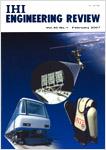Development of High Density Gas Engine 28AG

Development of High Density Gas Engine 28AG
- GOTO Satoru, TAKAHASHI Shinsuke YAMADA Takeshi, YAMADA Takayuki
The 28AG engine was developed since the market requires higher efficiency gas engines. As a result, 47.6% power generation efficiency, which is the highest in the world, was confirmed. Since the micro pilot ignition system, which this engine has adopted, can obtain powerful ignition energy, quick positive combustion of fuel-air mixture is enabled. Thereby, about the same high power generation efficiency and high output as a diesel engine can be obtained. The key points of highest power generation efficiency achievement are the original ignition system, adoption of the Miller cycle, optimization of pre-combustion chamber specification, optimization of fuel-air mixture formation process, and others.




